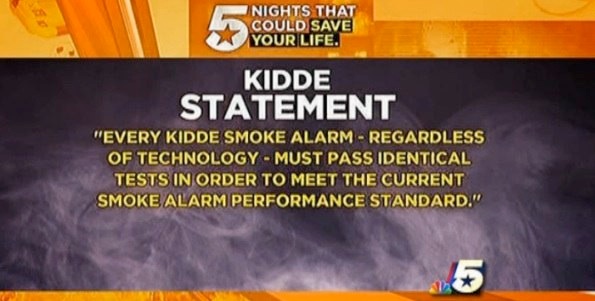





The Underwriters Laboratory, the standards writer for smoke alarms, is considering making its smoke-alarm tests much more stringent, NBC 5 has learned.
"The goal will be to challenge smoke alarms to better detect fires starting from both slow- smoldering and fast-flaming scenarios," the UL said in a statement. "UL believes this will help address nuisance alarms and challenge the devices to trigger faster than products currently on the market." UL's advisory panel is expected to take a vote on new standards in the next six months.
Consumers can do their own homework by reading smoke alarm labels before buying one.
Smoke alarm packaging typically states if the product is an ionization or photoelectric detector. People can look on the packaging for an "I" for ionization or "P" for photoelectric. Dual alarms will have both symbols on the box.
Experts recommend buying either:
-
• A photoelectric and an ionization detector
-
• Or a dual-sensor alarm
Ionization detectors use a small amount of radioactive material to create a small electric current between two plates. The alarm sounds when smoke enters the chamber. Ionization alarms are more sensitive to smaller particles of smoke found in flaming fires. The technology has proven to be not as effective with the larger particles found in smoldering fires.
Photoelectric technology uses a beam of light and is more sensitive to larger particles entering the chamber.
After spending more than a decade conducting tests and seeing results first hand, Russell knows what kind of protection he wants for his own loved ones.
"I want to know the earliest possible warning of any fire in my residence if I have my grandchildren sleeping in a bedroom down the hall," he said. "To get the fastest possible warning of a fire, you must use photoelectric technology at least by itself or in concert with ionization technology."
More:
Posted by NB5, Wednesday, Nov 9, 2011 - 10:19 PM CST
Extracted from NBC5 website, 27 Jan, 2012
"Smoke alarms save lives. According to the National Fire Protection Association (NFPA), the number of U.S. home
fire deaths has been cut by about half since the mid-1970's, when smoke alarms first became widely available.
A fire's very nature makes it unpredictable. Because no one can know when a fire will occur or what type of fire
they will have in their home, virtually every recognized fire authority and safety expert -- including NFPA, the U.S.
Fire Administration (USFA), Consumer Product Safety Commission (CPSC) and Underwriters Laboratories (UL) --
recommend having both photoelectric and ionization alarms for optimal protection against flaming and smoldering
fires. Kidde supports and states this recommendation on its packaging, website and in its owner's manuals.
Every Kidde smoke alarm -- regardless of technology -- must pass identical tests in order to meet the current smoke
alarm performance standard, UL 217."
First Alert/BRK, the other manufacturer used in the demonstration, also sent NBC 5 a statement:
"First Alert cannot comment on product testing done by third parties. Test results can be affected by many factors
and how the test was conducted. Test results are affected by product placement, the nature of the fire, air currents,
distance, air temperature, humidity, and many other factors. All relevant scientific studies of smoke alarms
recognize that ionization and photoelectric alarms may sound at different times depending on the type of fire.
However, these same studies found that either photoelectric or ionization alarms provide adequate time to escape
in most fires.
First Alert products are subject to rigorous internal testing on a frequent basis. We also meet or exceed standards
set by the American National Standards Institute (ANSI) / Underwriters Laboratories. The ANSI/UL's standards
result from stringent, independent testing and input from various interest parties, including fire services and
governmental agencies. That testing -- and the resulting standards -- is what consumers should look to in judging
product quality."
Not All Smoke Detectors Are Alike





World Fire Safety Foundation Comments:
Kidde Claims (copied from above):
Kidde: "Smoke alarms save lives. According to the National Fire Protection Association (NFPA), the number of U.S. home fire
deaths has been cut by about half since the mid-1970's, when smoke alarms first became widely available.”
WFSF: Fire deaths have been cut in half since the 1970‘s but to imply it is because of smoke alarms is grossly misleading.
Numerous factors such as less smoking, less cooking at home, safer electrical appliances, fire department education,
elimination of kerosene heaters, improved medical procedures etc have led to the reduction in fire deaths.
Kidde: “A fire's very nature makes it unpredictable. Because no one can know when a fire will occur or what type of fire they will
have in their home, virtually every recognized fire authority and safety expert -- including NFPA, the U.S. Fire
Administration (USFA), Consumer Product Safety Commission (CPSC) and Underwriters Laboratories (UL) --
recommend having both photoelectric and ionization alarms for optimal protection against flaming and smoldering fires.
Kidde supports and states this recommendation on its packaging, website and in its owner's manuals.”
WFSF: False. The official position of the International Association of Fire Fighters (IAFF) covers almost all US and Canadian
Fire Departments. The official position of the Australasian Fire and Emergency Service Authorities Council (AFAC)
covers every Fire Brigade throughout Australia and New Zeland. Both the IAFF and AFC only recommend photoelectric
smoke alarms. They do NOT recommend combination ionization/photoelectric smoke alarms.
More: US/Canada | Australia/New Zealand
Kiddie: “Every Kidde smoke alarm -- regardless of technology -- must pass identical tests in order to meet the current smoke
alarm performance standard, UL 217."
WFSF: If the UL217 test were a legitimate test then this would be a legitimate argument. However, UL is currently being sued
for their alleged fraudulent testing of ionization smoke alarms.
More: UL Lawsuit | Australia’s Flawed Smoke Alarm Standard | Australian & New Zealand Authorities Positions
First Alert Claims: (copied from above)
First Alert: "First Alert cannot comment on product testing done by third parties. Test results can be affected by many factors
and how the test was conducted. Test results are affected by product placement, the nature of the fire, air currents,
distance, air temperature, humidity, and many other factors. All relevant scientific studies of smoke alarms
recognize that ionization and photoelectric alarms may sound at different times depending on the type of fire.
However, these same studies found that either photoelectric or ionization alarms provide adequate time to
escape in most fires.”
WFSF: The official positions of both the IAFF and AFAC state: “Ionization smoke alarms may not operate in time to alert
occupants early enough to escape from smoldering fires.”
More: US/Canada | Australia/New Zealand
First Alert: “First Alert products are subject to rigorous internal testing on a frequent basis. We also meet or exceed standards
set by the American National Standards Institute (ANSI) / Underwriters Laboratories. The ANSI/UL's standards
result from stringent, independent testing and input from various interest parties, including fire services and
governmental agencies. That testing -- and the resulting standards -- is what consumers should look to in judging
product quality."
WFSF: If the UL217 test were a legitimate test then this would be a legitimate argument. However, UL is currently being sued
for their alleged fraudulent testing of ionization smoke alarms.
More: UL Lawsuit | Australia’s Flawed Smoke Alarm Standard | Australian & New Zealand Authorities Positions




WFSF Closing Comments:
In 1980 the International Association of Fire Chief’s (IAFC) ‘Residential Smoke Alarm Report’ warned against ionization smoke alarms stating they were not safe, that lives were at risk, and for Fire Chiefs to ONLY recommend photoelectric smoke alarms and heat alarms. The IAFC also warned against combination ionization/photoelectric alarms due to increased cost with little benefit, and the false alarm problem inherent in ionization technology:
www.theWFSF.org/iafc | www.theWFSF.org/combocon
Tragically the IAFC’s message was no match for the marketing muscle of the ionization smoke alarm manufacturers.
In 2006, when the truth about ionization smoke alarms finally began to emerge with the testing conducted by the Barre City Fire Department, the smoke alarm manufacturers could no longer keep the truth from the public:
www.theWFSF.org/ffus
So what was the manufacturers response after selling their deadly ionization technology for three decades - when almost every home in the USA, Canada, Australia the U.K. and New Zealand only had ionization alarms installed - when most fire fighters knew next to NOTHING (through no fault of their own) about photoelectric smoke alarms?
“You don’t know what type of fire you are going to have so you need BOTH ionization AND photoelectric.”
From a money making and face saving perspective this is a brilliant solution for the manufacturers.
But is it the best solution for the public?
Should we Trust the Manufacturers or our Fire Departments?
Where were the manufacturers from 1980 - 2006? Why didn’t they warn us about ionization alarms? Should consumers now listen to the manufacturers who are desperately trying to cover their butts due to the thousands of needless deaths and injuries since 1980?
Or would it make more sense to take heed of the official (IAFF and AFAC) positions of our Fire Departments?
"I had no idea there was such a difference between the two detectors."
Fire Chief Mark Crawford, Somervell County, Texas, USA 10 Nov, 2011
Tests show some detectors don't perform as well in slow, smoldering fires
By Kimberly King | Thursday, Nov 10, 2011 | Updated 2:04 AM CST

Fire Marshal Dwayne Griffin, Somervell County, Texas, USA 10 Nov, 2011
The first ionization alarm sounded 22 minutes into the demonstration. As the room continued to fill with smoke, the couch caught on fire. The second ionization detector went off 28 minutes in.
"It wasn't until [the] free-burning stage [when] it was completely unsurvivable that the fourth detector, which was the No. 2 ionization, went off," Griffin said.
Somervell County fire Chief Mark Crawford, who came to watch the demonstration, said it surprised him.
"I had no idea there was such a difference between the two detectors," he said.
A second demonstration had similar results, though the smoldering developed more slowly.
Once again, two photoelectric and two ionization alarms were installed in the demonstration room, and Griffin put the iron between two couch cushions.
None of the detectors had gone off at 25 minutes in.
"He just went on air," Craft said while watching the demonstration through Plexiglass. "It's hard to believe smoke's up there on all of them."
The first photoelectric sounded at 33 minutes. The second photoelectric went off seconds later.
More than 10 additional minutes went by before the two ionization alarms sounded.
"When the ionization started sounding, you could not see to get out of your home," Griffin said. "It's an eye-opener, for sure."
All of the smoke-alarm manufacturers used in the demonstration make ionization and photoelectric detectors, as well as dual-sensor alarms.
Dual-sensor alarms are considered the best protection a homeowner can have to escape smoldering and flaming fires.
Kidde, one of the manufacturers, sent NBC 5 a statement that read in part:

-
a.By modifying the smoldering fire test in UL Standard 217 to eliminate materials that
presented foreseeable challenges to ionization smoke alarms. . . .
c. By failing to formulate and implement safety standards for ionization smoke alarms that
require ionization smoke alarms to detect slow smoldering fires in a timely manner . . .”



America & Australia’s Flawed Smoke Alarm Standards




S O R R Y!
If you are able to read this text
it is because you are probably on
an iPad or other device that does
not support Adobe’s Flash technology.
To see this film you will need to
watch it on a computer.

Click Play
to see film










